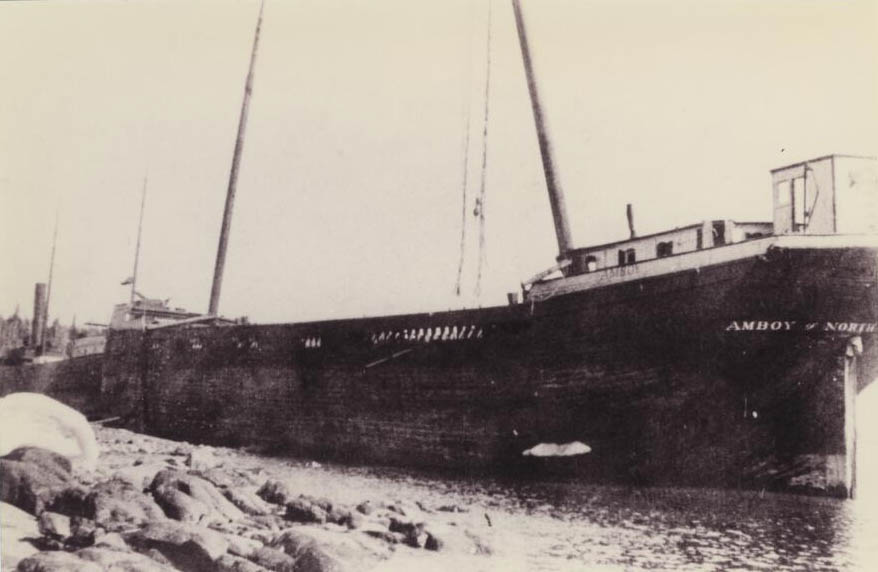“We arrived at the location of the SS George Spencer and SS Amboy shipwrecks from the infamous storm on November 29, 1905, after a short canoe ride. Massive platform-sections of wreckage are located approximately fifty feet offshore, at a depth of about five feet or so below the surface. When the storm ran them both aground, we initially believed we were gazing at sections of the Amboy, but it turns out that we were looking at the Spencer“
A.F. Eklund
In Lake Superior, off the coast of Schroeder, Cook County, Minnesota, in the United States, the Amboy was a wooden schooner barge that capsized together with her towing steamer, the George Spencer. The Amboy’s remnants were registered to the National Register of Historic Places in 1994.
The wooden schooner barge known as the Amboy was built especially for the iron ore trade in Minnesota. Cleveland, Ohio-based Quayle & Murphy constructed her in 1874. She measured 209.3 feet (63.8 meters) in length, 34.2 feet (10.4 meters) in beam, and 14.4 feet (4.4 meters) in cargo hold. Her net tonnage was 849 tons, while her total tonnage was 893 tons. She was capable of transporting about 1,500 tons of goods. Helena was her original name. One person lost their life when the Helena sank in a collision in Little Mud Lake, St. Marys River, in July 1891.
The Amboy, loaded with water, landed in Cleveland, Ohio, on August 26, 1892. She was caught in a storm while driving from Escanaba, Michigan. The water seeping into her hull eventually became too much for the pumps to handle. The tugboats Gregory and Blazier eventually came to her rescue; they towed the Amboy to Cleveland.
In Buffalo, New York, near the base of Georgia Street, the Amboy ran aground on October 14, 1893. The steamer Helena had her in tow when the severe wind caused her to break free. Tugboats lifted the Helena off the Amboy. She eventually received help from the tug Cascade, and after working for about 30 minutes, she was set free.
Around 10:00 a.m. on September 5, 1898, the Amboy grounded in the Niagara River close to Germania Park. The tug James Byers was towing her; she was headed out of Tonawanda, New York, carrying iron ore in her cargo hold. She ran aground when her keel struck the bottom due to low water levels. She was not liberated by the Byers. After a while, the tugs Cascade, Hibbard, and Conneaut came to attempt her release but were unsuccessful as well. Additionally, a lighter was dispatched to attempt to save her by taking part of her cargo.
Final Voyage
When the Amboy and the wooden bulk freighter George Spencer were hit by the full force of the Mataafa Storm on November 28, 1905, they were travelling from Buffalo, New York to Duluth, Minnesota, carrying a shipment of coal. Eighteen ships were found to be stranded or wrecked after the storm passed; the steamer Ira H. Owen was one of the ships that had lost all of its crew. In an effort to save both ships, the Spencer’s crew severed the line that separated her and the Amboy. They drove both boats ashore. The local fishermen set up a breeches’ buoy, which let the ship’s crew to escape.
“Both boats lost their bearings in the snowstorm and landed on a sandy beach. As soon as they struck, buoys with lines were thrown over the side. When they floated ashore they were caught by fishermen and made fast. With an improvised life buoy rigged in the hawsers the entire crew were taken safely to shore preceded by Mrs. Harry Lawe, wife of the mate, who was acting as steward. The vessels ran on the rocks Tuesday morning, and for thirteen hours the situation of the crew on the battered hulks was desperate. Fishermen rushed into the surf almost to their necks and aided the sailors to escape. The Spencer’s cargo can be lightered but there is little hope for saving the boat. The vessels were coming up without cargo to load ore. Capt. Frank Conland sailed the Spencer and Fred Watson was master of the Amboy. The Spencer was valued at $35,000 and the Amboy at $10,000.“
December 1, 1905 Duluth Evening Herald

“Captain C.O. Flynn returned last evening from an inspection of the stranded steamer George Spencer and schooner Amboy. He said “the schooner Amboy is a total wreck … the steamer Spencer is still in good shape. Her hatches are intact, and she does not appear to be seriously damaged. As to the condition of her bottom that cannot be told at present.“
December 6, 1905 issue of the Duluth News Tribune assessment of the wrecks:
Today
The wreck of the Spencer is not too far from the Amboy’s wreckage. Covered in cobbles and sand, the remnants of the Amboy’s 74-foot (23-meter) keelson remain. The waves have worn away the portion of her keelson that runs parallel to the shore; it is made up of adjacent white oak timbers. It is fastened with hundreds of 1.25- and 875-inch-diameter iron bolts and stands two timbers high. There is an upright timber that appears to be a portion of her centerboard close to the southern end of the timbers. Google Earth and other satellite photography make it simple to see these relics.






